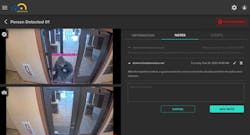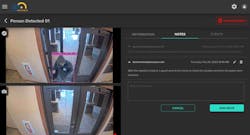ISC West Exhibitor Q&A: Cloudastructure
Although the security industry typically lags well behind the IT world when it comes to leveraging new network technologies, the adoption of cloud surveillance solutions has grown exponentially in recent years. With the proliferation of high-resolution cameras and AI-powered analytics throughout the market, the infrastructure requirements for onsite deployments have simply become too burdensome and costly for many end-users and have subsequently driven increased demand for cloud offerings.
In fact, according to a report published by market research firm Memoori last year, more than 30 companies have become suppliers of cloud access control or video surveillance technology over the past several years and the market is expected to grow at a compound annual growth rate (CAGR) of approximately 12% over the next five years.
Additionally, the onset of the Covid-19 pandemic in early 2020 also showed businesses the criticality of having remote access and management capabilities for their security systems, thereby providing another growth driver for the industry.But while many companies are just now catching on to the benefits of cloud solutions, Cloudastructure, which was founded nearly two decades ago, has been one of the pioneers in the field. SecurityInfoWatch.com (SIW) sat down with Rick Bentley, the company’s founder and CEO, to learn more about the company’s origins and some of the trends that are having the biggest impact on the market.
SIW: How did Cloudastructure get its start?
Bentley: We are the longest-running, cloud-based video surveillance company in the world. I started it in 2003. I was previously doing a startup backed by Softbank that was eventually bought by Uber. We had a nice office space in downtown San Francisco – we already had access control, an [intrusion] alarm, and someone at the front desk – but still someone around lunchtime one day when people were going in and out, walked in dressed like everyone else, took a notebook computer off a desk and walked out again. And no one thought to stop them because we were hiring like crazy and there were a bunch of new faces around and everything else.
When the guy came back, we knew the building had cameras, so we went to go pull the video and the landlord said, “Oh, looks like someone unplugged [the surveillance system] to plug in the vacuum cleaner and it never came back up.” I said, “Well, how come it doesn't send you an alert? How come it's not monitored? How come the data is on-premises? This was two decades ago and I said, “Why did you buy such a crappy system? “He said, “I don't know anything about video surveillance, I'm running Class A real estate in the hottest market on the planet of our lifetimes right now in the dot-com boom and I just bought the most expensive one.” I said, “Wow, that industry sucks, maybe I should go try and do something there someday.” So, a few years later, I did.
SIW: What do you see as the biggest trends impacting the market currently and how do you see them evolving?
Bentley: I think the biggest one is computer vision. A long time ago, another company had a slogan, “How many cameras do you have until you can't see anything?” That still rings true to me today. If you have 100 cameras and I asked you what happened in the last 24 hours? Ok, well that is three, eight-hour days per camera to watch the video at 1x speed times 100 cameras, so it is 300 days – nearly a calendar year. You can probably watch it on 10x speed and still figure out what happened, but even watching it at 10x is still a calendar month. With computer vision, if I need to see all the bicycles or whatever, you can do that. One-hundred camera systems are not that big nowadays, especially for an enterprise with multiple locations. Computer vision just makes the data accessible again. Computers don't sleep and they work for peanuts.
SIW: We’ve heard a lot throughout the course of the pandemic about how it shined a spotlight on the capabilities and benefits of cloud solutions in security. What kind of impact have you seen as a result of that?
Bentley: I would say very mixed. We found mask/no mask very straightforward to apply. We can give you a very nice graph that shows what your compliance is by camera, building, state or county to see what percentage of people are or aren't wearing masks. We don't try and do it to play Big Brother, we do it so that the business can keep their layers of government above them off their back.
One thing that did not work out well at all is social distancing. And it's easy enough, we can tell you when people are or aren't six feet apart. We’ve got that down pat. The problem is if a family of four goes to the mall, they walk in together all within six feet of each other. Two of them go to the women's clothing store and two of them go to the men's clothing store. On the way, one of them goes to the bathroom and all four get back together again. Was there a social distancing violation then? How do you keep track of all that? It just becomes a confusing mess before you can really get your arms around the problem.
SIW: Can you tell us about your go-to-market strategy?
Bentley: We have a mixed model. We have some integrators, who are great by the way, and they bring in business we never would have found. At the same time, we have a direct sales force that goes out and finds businesses in different verticals that those integrators never would have found. If we flip the account to a local integrator who does the installation, that's great and if the [end user] has an in-house facilities group that are the only ones allowed to pull cables in the building, that's great too.
SIW: What is the profile of your typical customer?
Bentley: Multiple locations, the more the better. If we're selling one-to-one for a one location system, we’ve got some advantages and we’ve got some disadvantages. It is here or there. But if you’ve got 10, 20 or 100 locations, just the cloud is 100% the way to go. One dashboard shows where everything is, all the data is accessible with one login, and you can track people from one building to another. It is really hard to do that with a bunch of NVR silos. And that transcends industries and markets. It just really comes down to who has multiple locations.
Joel Griffin is the Editor of SecurityInfoWatch.com and a veteran security journalist. You can reach him at [email protected].
About the Author
Joel Griffin
Editor-in-Chief, SecurityInfoWatch.com
Joel Griffin is the Editor-in-Chief of SecurityInfoWatch.com, a business-to-business news website published by Endeavor Business Media that covers all aspects of the physical security industry. Joel has covered the security industry since May 2008 when he first joined the site as assistant editor. Prior to SecurityInfoWatch, Joel worked as a staff reporter for two years at the Newton Citizen, a daily newspaper located in the suburban Atlanta city of Covington, Ga.


